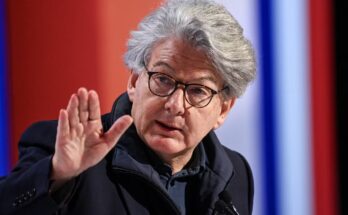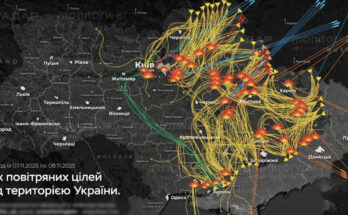On a journey that includes New York and, above all, Mexico City, Camilo undertakes a compelling and somewhat detective investigation which, in turn, translates into a sort of journey of self-discovery. His personal adventure, however, is based on almost absolute uncertainty. At most, she gets a vague hint from her mother and an intuition: that Miguel Carnero, once a young man obsessed with the kidnapping of a Nazi engineer, is her biological father. This would be, in broad terms, the premise of my father’s names (Anagrama, 2025), the most recent novel by Mexican narrator, essayist and translator Daniel Saldaña París (1984).
“The idea for this novel came to me at a certain point during the pandemic. My father was ill with cancer and things didn’t seem good at all. Then we both started talking a lot. I wanted him to tell me his world before I was born”, says Saldaña, and also that those conversations, which he still recorded, were only the starting point for a story that is in no way autobiographical.
“This book was also a way to reacquaint myself with Mexico City. Because I have spent time abroad and lived far away at different times, I feel that one way to anchor myself to the city is to research it,” he continues. Certainly, my father’s names It is a tribute to the great Mexican city, but also to the young people who lived there in the seventies: a generation that grew up expecting great revolutions and utopias without managing to achieve any. Years later, Saldaña and Camilo, author and narrator, each for their respective reasons, converge in the creation of an individual who summarizes the spirit of that time: the elusive Miguel Carnero, perhaps one of the most enigmatic and magnetic characters of Mexican literature in recent years.
With this novel, Daniel Saldaña, author of other books such as Dance and fire (Anagrama, 2021) e The main nerve (Sexto Piso, 2018) – transforms memory into a gigantic and overwhelming imaginary space like Mexico City; a space with dark areas, worn streets, a center, several suburbs, some opulent neighborhoods and many forgotten ones. It also seems to say that type of urban planning from the past my father’s namesit’s what determines how our memories define us.
Ask. There is a sort of narrative structure in your novel that runs parallel to the urban structure of some parts of the city, in particular of Ciudad Sat Elite, which was Miguel Carnero’s obsession.
Answer. At first I started to get really into Mario Pani and read a lot about architecture. I was interested in the idea of the city of Pani. As it happens, my father was born in Ciudad Satelite and I grew up visiting that place. It always seemed like a very strange part of the city to me, because it has a kind of suburban spirit, but it has nothing to do with the gringo suburbs. Reading about Satellite was a way to reclaim that part of the city, which isn’t really mine. I grew up in the South, in Coapa, although I went to Satelite because my grandmother lived there.
Q. I suppose it was in that phase of the investigation that the figure of Karl Fiebinger, the Nazi engineer who left his mark on the city, comes to mind.
R. YES. Researching the history of Sat Elite, I first found the Pani project, which was very utopian and did not have a gringo suburb as its model, but rather a much more original idea, which involved the integration of various social sectors. But Pani at a certain point abandoned that utopian project (also because there was rampant corruption in the State of Mexico), and several developers joined, including this guy, Fiebinger, who has that dark past during the Nazi regime.
Then I started writing the novel. I started it outside of CDMX because I had a wonderful grant from the New York Public Library. I had already written down some information about Fiebinger when I left, but I became more involved there, because the Library had many books on Nazi constructions, including a series of secret tunnels that the Nazis built in Austria. And then the name Karl Fiebinger and his connection to these tunnels, a couple of crematoria associated with concentration camps, and an underground missile factory began to pop into my mind more. I eventually filed a request for information with the FBI and the National Archives in Washington, since Fiebinger, like other technicians and scientists with a Nazi past, was brought to the United States after World War II and integrated into the job market as if nothing had happened. The research became a bit excessive, until I said to myself, “enough, I’m a fiction writer and I can fill in the gaps with whatever comes to mind.”
Q. I would like to focus on this last point and know how you deal with the challenge of uniting reality and fiction. Aren’t you afraid that the imaginary part betrays the real part too much or that, instead, the attachment to reality could limit the fiction?
R. I think in this novel I approached the question very freely. I did a lot of research, and a good part of what I researched ended up coming out, for example: things about other figures in Latin American politics of those years and about clandestine communist, Trotskyist organizations, etc. My strategy was to read everything I could, absorb the zeitgeist and real facts that might be useful to me, and then forget about all that as much as possible and focus on the characters and the plot, on how to order those events in a way that made sense for the novel. And I underline “for the novel”, because I write fiction, not history.
Q. I feel that this novel follows a tradition of Mexican literature marked by Pedro Paramo: the search for the father. There is the mother who sends her son (or suggests to him, in this case) to look for his father. And the fact that Carnero “could have been” Camilo’s father reminds me of Eduviges’ character when she tells Juan Preciado that she “could have been” his mother.
A. Of course, this is a tradition that interests me. The absence of the father is a Latin American theme not only in literature, but in reality, and used in fiction it also serves to invent a figure of the father. Playing with the father figure means creating your own identity and building a lineage that makes sense or generates conflict with who you are or who you think you are. In this case, more than on the absence of the father, I was interested in focusing on the multiplicity of fathers. It’s not that he didn’t know his father, but it’s possible that there were many fathers, or that the space occupied by a father could be divided between the father and another person. And in this sense it is more of a novel of lateral paternity.
D. Another detail that attracts attention is the parallelism between the generations that Carnero and Ángela respectively embody: both dreamers, eager to change their socio-political environment, even if in the end everything remains in a sort of frustration. All that rebellious spirit remains only something youthful, barely a myth…
A. I think there is a good deal of frustration in my parents’ generation and in other generations close to me who were very politically active, and it even seems that this rebellion had no consequences. But he had them, because some things changed in ’68 and ’71. Some of these consequences are found in the current changes in Mexico, which we may or may not agree with.
On the other hand, it is no small thing that myths or ideas of a possible future remain. Generating imagination is a political exercise. Even if it is a city idea. In fact, I think that when we think more at a city level and less at “society” the change becomes more concrete. This is why I am very interested in the city as a political horizon. I have reread many classics that talk about the city as an updatable political horizon. For example, Aristotle argued that a manageable political organization must be a city. He said it couldn’t exceed 10,000 inhabitants, so in CDMX it was already out of our hands. But even so it seems to me to be a valid political horizon for thinking about everyday life. And this is an urgent battle. It doesn’t seem like a coincidence that CDMX talks so much about gentrification. I think that in the city, starting from issues such as access to public housing (the novel also talks about this), a political discourse is articulated that must be considered.
D. I also wanted to say that, despite the frustration that these generations may feel, the novel highlights what survives every shared utopia: affection, friendship.
A. This is something I see in my parents’ generation. They participated extensively in the movements supporting the Salvadoran guerrillas in the 1980s. They are not exactly Carnero’s generation, but a little younger; but they were very active. And although years have passed, there are networks that were formed then and that are still alive: networks of friends, but also networks for the relocation of exiles. And this is maintained thanks to friendship and romantic relationships, which also have a social and public function.
P. I think one of the great successes of my father’s names It’s how you resolve the ending. Could Miguel Carnero be Camilo’s biological father? This is the central question of the book. We can think yes or no, but it all depends on a memorable pretend game.
R. As I wrote, I realized that I didn’t have to have a frontal response within the reality of the novel, that I had to construct that other fiction. I’m not entirely clear why, but I feel like it had to do with the psychoanalysis reading I was doing about the following: The biological reality of who your father was isn’t that important, but rather what stories you can make up to create an identity that allows you to continue functioning in life. And that’s kind of what I did with the book, I thought about it while my dad was dying. The novel has nothing directly to do with my father, but I made up a story that would distract me and allow me to have my own secret world in my head. A world in which his illness did not occur and which allowed me to rework reality through fiction.



